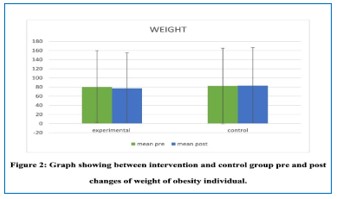Effect of Suryanamaskara and Heating Pranayama on Grade 1 Obesity - A Randomized Controlled Trial
DOI:
https://doi.org/10.21760/jaims.9.1.3Keywords:
Suryanamaskara, Ayurveda, Yoga, Heating Pranayama, ObesityAbstract
Background: Obesity is a prevalent health condition in society with potentially fatal side effects that can result in serious disability. The objective of this study was to assess the Effect of Suryanamaskara and Heating Pranayama on Body Mass Index, Waist circumference, Skin fold thickness among obese individuals. Materials and Methods: A total of 60 subjects aged 18-30 years were screened and after filling inclusion criteria as well as diagnostic criteria (WHO criteria of obesity) 30 subjects were recruited to the study. Suryanamaskara and Heating Pranayama was given for the duration of 45 minutes each for 5 days. Results: Study results demonstrate that there is a significant decrease in Body Mass Index (BMI), Waist Circumference (WC), and Skin Fold Thickness (SKF) in the study group after 45 minutes of Suryanamaskara and heating Pranayama practice for 4 weeks, while there is no improvement in the control group. Discussion: The study reveals that practice of Suryanamaskara and heating Pranayama can help the people suffering from obesity. So, finally it can be concluded that the practice of Suryanamaskara and heating Pranayama can help to manage Grade 1 obesity.
Downloads
References
Prof C.Das, P.K Das. Text book of medicine. 6th Edition. Current book International. July 2016:60, Lenin Sarani, Kolkata: pg544
Rajeenv Ahewar, Prakash Mondal. Prevalence of obesity in India: A systemic review diabetes and metabolic syndrome: Clinical research and review. January-February 2019; 13(1):318-321.
P Alagappan. Manual of practical medicine 5th Edition. Jaypee Brothers Medical publishers(P) Ltd. 2014:pg76, 78
Susan B Racette, Susan D Deusinger, Robert H Deusinger. Obesity: Overview of Prevalence, Etiology, and Treatment. Physical Therapy and rehabilitation journal.1 March 2003; volume 83(3):276-288
BKS Iyenger. Light on yoga sutras of Patanjali. Harper Collin Publishers. 2002: pg17
Swami Satyananda Saraswati. Asana Pranayama mudra bandhas, 2nd edition. Yoga publication trust, Munger, Bihar India 1973: pg 162-172,405,410
Swami Muktibodhananda. Hatha yoga pradipika, 4th edition. Yoga publication trust, Munger, Bihar school yoga. 2012; pg149, 220, 252.
Varun Malhotra, Usha Dhar, Rinku Garg, Sameer S, Archana S, Jayanti et al. Anuloma viloma pranayama modifies reaction times and autonomic activity of heart: A pilot study. International journal current research and review Oct 2012; 4(19):146-149.
Jakhotia KA, Shimpi AP, Rairikar SA, Mhendale P, Hatekar R, Shyam A,et al. Suryanamaskar: an equivalent approach towards management of physical fitness in obese females. Int J Yoga 2015;8(1):27-36.
Patil SV, Gaikwad PB, Jadhav ST. Effect of pranayama on body mass index in young medical students. Int J Res Rev. 2016; 3(2):24-27.
Harsh Mohan. Text book of pathology. 7th edition. Jaypee Brothers, Medical Publishers. 2015:pg239
Mohsen Rostami, Amir Hosein Yekta, Pardis Noormohammadpon, Farzin Farahbakhsh, Mahboobeh Kordi, and Ramin kordin. Relation Between lateral abdominal muscles thickness, Body mass index, Waist circumference and Skin fold thickness. Ada Medica Iranica 2013; 51(2): 102
Noormohammadpour P, Kordi R, Dehghani S, Rostami M. The effect of abdominal resistance training and energy restricted diet on lateral abdominal muscles thickness of overweight and obese women. Journal of bodywork and movement therapies. 2012 Jul 1;16(3):344-50.
Park k, Epidemiology of chronic and non- communicable disease and condition, Park textbook of prevention and social medicine ,23rd edition, M/s Banarsidas Bhanot publishers January 2006: pg 399.
Raghuraj Puthige, Shirley Telles. Right nostril yoga breathing influence ipsilateral components of middle latency auditory evoked potentials. Neurological sciences Jan 2005;25(5):274-80.
Dai CL, Sharma M, Chen CC, Yesilyurt E, Godbey S. Yoga as an alternative therapy for weight management in child and adolescent obesity: A systematic review and implications for research. Altern TherHealth Med 2021;27:48‑55
Sarvottam K, Yadav RK. Obesity‑related inflammation & cardiovascular disease: Efficacy of a yoga‑based lifestyle intervention. Indian J Med Res 2014;139:822‑34.
Bhutkar MV, Bhutkar PM, Taware GB, Surdi AD. How effective is sun salutation in improving muscle strength, general body endurance and body composition? Asian J Sports Med 2011;2(4):259-66
Sharpe PA, Blanck HM, Williams JE, Ainsworth BE, Conway JM. Use of complementary and alternative medicine for weight control in the United States. J Altern Complement Med2007; 13 : 217-22
Kristal AR, Littman AJ, Benitez D, White E. Yoga practice is associated with attenuated weight gain in healthy, middle-aged men and women. Altern Ther Health Med 2005; 11 : 28
Katherine E, Alessandro P, Carmen DP, Giovanni G,Mariengela M, Raffaele M, et al. Effect of weight loss and life style changes on vascular inflammatory markers in obese women. JAMA 2003; 289 : 1799-804.
Lee JA, Kim JW, Kim DY. Effects of yoga exercise on serum adiponectin and metabolic syndrome factors in obese postmenopausal women. Menopause 2012; 19 : 296-301
Yadav RK, Magan D, Mehta N, Sharma R, Mahapatra SC.Efficacy of a short term yoga based lifestyle intervention in Sarvottam & Yadav : Yoga -based intervention for obesity related CVD reducing stress and inflammation: Preliminary results. J Altern Complement Med 2012; 18 : 662-7.
Sarvottam K, Magan D, Yadav RK, Mehta N, Mahapatra SC. Adiponectin, interleukin‑6, and cardiovascular disease risk factors are modified by a short‑term yoga‑based lifestyle intervention in overweight and obese men. J Altern Complement Med 2013;19:397‑402.
25.Yadav R, Yadav RK, Khadgawat R, Pandey RM. Comparative efficacy of a 12 week yoga-based lifestyle intervention and dietary intervention on adipokines, inflammation, and oxidative stress in adults with metabolic syndrome: a randomized controlled trial. Translational Behavioral Medicine, Volume 9, Issue 4, August 2019, Pages 594–604.
Patil SV, Gaikwad PB, Jadhav ST. Effect of pranayama on body mass index in young medical students. Int J Res Rev. 2016; 3(2):24-27.















